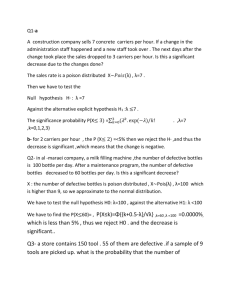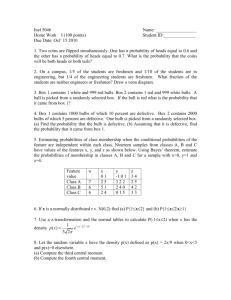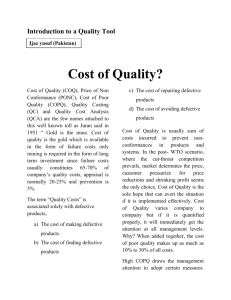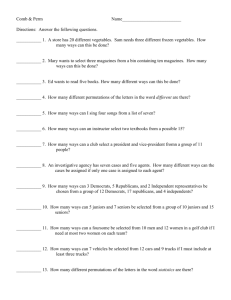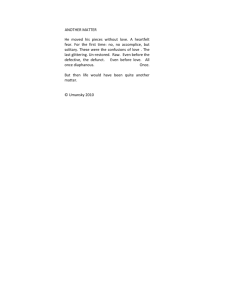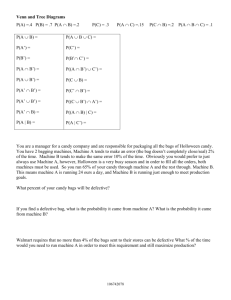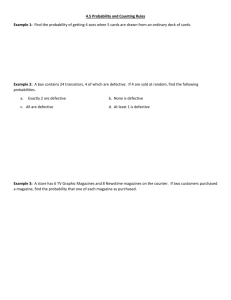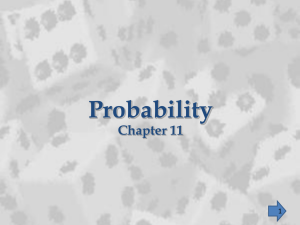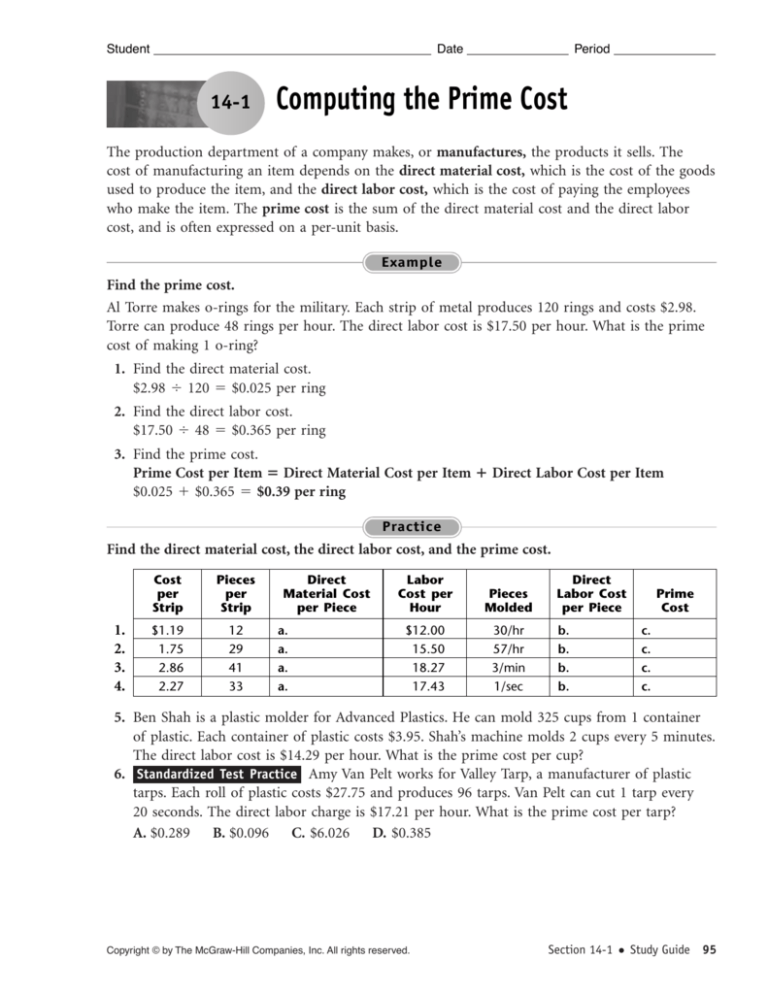
Student
Date
14-1
Period
Computing the Prime Cost
The production department of a company makes, or manufactures, the products it sells. The
cost of manufacturing an item depends on the direct material cost, which is the cost of the goods
used to produce the item, and the direct labor cost, which is the cost of paying the employees
who make the item. The prime cost is the sum of the direct material cost and the direct labor
cost, and is often expressed on a per-unit basis.
Example
Find the prime cost.
Al Torre makes o-rings for the military. Each strip of metal produces 120 rings and costs $2.98.
Torre can produce 48 rings per hour. The direct labor cost is $17.50 per hour. What is the prime
cost of making 1 o-ring?
1. Find the direct material cost.
$2.98 120 $0.025 per ring
2. Find the direct labor cost.
$17.50 48 $0.365 per ring
3. Find the prime cost.
Prime Cost per Item Direct Material Cost per Item Direct Labor Cost per Item
$0.025 $0.365 $0.39 per ring
Practice
Find the direct material cost, the direct labor cost, and the prime cost.
1.
2.
3.
4.
Cost
per
Strip
Pieces
per
Strip
$1.19
1.75
2.86
2.27
12
29
41
33
Direct
Material Cost
per Piece
a.
a.
a.
a.
Labor
Cost per
Hour
Pieces
Molded
$12.00
15.50
18.27
17.43
30/hr
57/hr
3/min
1/sec
Direct
Labor Cost
per Piece
b.
b.
b.
b.
Prime
Cost
c.
c.
c.
c.
5. Ben Shah is a plastic molder for Advanced Plastics. He can mold 325 cups from 1 container
of plastic. Each container of plastic costs $3.95. Shah’s machine molds 2 cups every 5 minutes.
The direct labor cost is $14.29 per hour. What is the prime cost per cup?
6. Standardized Test Practice Amy Van Pelt works for Valley Tarp, a manufacturer of plastic
tarps. Each roll of plastic costs $27.75 and produces 96 tarps. Van Pelt can cut 1 tarp every
20 seconds. The direct labor charge is $17.21 per hour. What is the prime cost per tarp?
A. $0.289 B. $0.096 C. $6.026 D. $0.385
Copyright © by The McGraw-Hill Companies, Inc. All rights reserved.
Section 14-1
Study Guide 95
Student
Date
14-2
Period
Calculating the Break-Even Point
A break-even analysis determines how many units of a product must be made and sold to cover
production costs. The break-even point on a chart shows you the exact point where income from
sales equals the cost of production. Any units sold after this point result in a profit for your
business. To calculate the break-even point you must know the total fixed costs, like rent and
salaries, and the total variable costs, which vary with the number of units produced.
Example
Find the break-even point in units.
Ace Manufacturing produces o-rings for the military. It plans to manufacture 433,000 o-rings to
be sold at $0.40 apiece. The fixed costs are estimated at $114,000. Variable costs are $0.085 per
unit. How many o-rings must be sold for Ace to break even?
1. Find the break-even point.
Break-Even Point in Units Total Fixed Costs (Selling Price per Unit Variable Costs
per Unit)
$114,000 ($0.40 $0.085) $114,000 $0.315 361,905 units
Practice
Find the break-even point.
1.
2.
3.
4.
Total Fixed
Costs
Selling Price
per Unit
Variable Costs
per Unit
$127,000
139,500
188,750
223,392
$0.98
0.72
1.63
4.26
$0.36
0.51
1.19
3.38
Break-Even
Point in Units
5. Webb Manufacturing produces metal washers. The selling price per washer is $0.18. The
variable cost per washer is $0.09. Fixed costs total $357,000. What is the break-even point in
number of washers?
6. Advanced Plastics makes plastic cups. The cups sell for $2.29 each. The variable costs per cup
include $0.79 for supplies and $1.01 for direct labor. Fixed costs total $575,000. What is the
break-even point in number of cups?
7. Simplified Homes manufactures modular homes. The fixed costs total $1,332,477. The base
price of each home is $135,000 and the base variable cost is $99,531 per home. What is the
break-even point in number of modular homes?
8. Standardized Test Practice Valley Tarp manufactures plastic tarps. It has total fixed costs of
$817,359. The selling price of each tarp is $21.95. The variable cost per tarp is $12.17. What is
the break-even point in number of tarps?
A. 37,237 B. 67,162 C. 83,575 D. 817,359
96 Section 14-2
Study Guide
Copyright © by The McGraw-Hill Companies, Inc. All rights reserved.
Student
Date
14-3
Period
Computing the Percent
of Defective Goods
A quality control inspector checks mass-produced items. An item that’s the wrong size or
damaged is classified as defective. A quality control chart shows the percent of defective items
allowable. The production process is said to be “out of control” if the actual percent of defective
items is greater than the percent allowable.
Example
Determine if the process is in or out of control.
Ace Manufacturing produces o-rings for the military. The quality control inspector checked 75
rings and found 4 that were defective. The process is “out of control” if more than 4 percent of
the sample is defective.
1. Find the percent defective.
Percent Defective Number Defective Total Number Checked
4 75 5.33%
2. Compare the percent defective to the percent allowable.
5.33% is more than 4%. The process is out of control.
Practice
Find the percent defective and if the process is in or out of control. If more than 4.5 percent is
defective, the process is out of control.
1.
2.
3.
4.
Number
Defective
Number
Checked
3
6
4
7
125
125
150
150
Percent
Defective
a.
a.
a.
a.
In or Out
of Control
b.
b.
b.
b.
5. Twice a day Tanisha Williams inspects metal washers for defects. Her last check yielded
47 defective washers out of 1,200. If more than 4 percent is defective, the process is out of
control. What is the percent defective? Is the process in or out of control?
6. Standardized Test Practice Every 2 hours the quality control inspector at Valley Tarp checks
a random sample of 48 tarps for defects. The process is considered out of control if more that
5 percent are defective. Yesterday she got the following results: 9 A.M.—1 defective; 11 A.M.—
3 defective; 1 P.M.—1 defective; 3 P.M.—2 defective; 5 P.M.—4 defective. How many times was
the process out of control?
A. Once B. Twice C. Three times
D. None
Copyright © by The McGraw-Hill Companies, Inc. All rights reserved.
Section 14-3
Study Guide 97
Student
Date
14-4
Period
Computing Number of Units Produced
A time study is conducted to determine how long a particular job should take. It involves
watching an employee complete a job, recording the time required for each task, and calculating
the average time for each task. Averages from these results can then be used to determine how
many units a worker can produce in a fixed period of time.
Example
Find the number of units.
Al Torre makes o-rings for the military. He works 9 hours per day with a half hour off for lunch
and 4 10-minute breaks. He spends 3 minutes producing each ring. How many rings should Torre
be able to produce each day?
1. Find the actual time worked.
[(9 hrs 60 min/hr) 30 min (4 10 min)] 470 minutes
2. Find the number of units.
Number of Units Actual Time Worked Average Time Required per Unit
470 min 3 min 156.67 rings
Practice
Find the number of units produced.
1.
2.
3.
4.
Actual Time
Worked
Average Time
per Unit
60 seconds
20 minutes
1 hour
1 hour
2.5 seconds
45.5 seconds
3.5 minutes
5 seconds
Number of
Units
5. Sophie Cross punches washers out of metal sheets. Every 2 hours she takes a 10-minute break.
She averages 50 seconds per sheet of metal. How many sheets can Cross punch every 2 hours?
6. Tran Nguyen is a plastic cup molder. Every hour he takes a 5-minute break. He averages
6.5 minutes per cup. How many cups can Nguyen mold in a 4-hour period?
7. Standardized Test Practice Stan Riddle is employed as a press operator by Valley Tarp, a
manufacturer of plastic tarps. He works a 10-hour shift, 4 days a week. Every day he gets
45 minutes off for lunch and a 7-minute break 3 times a day. He averages 10.2 minutes per
tarp. How many tarps can Riddle produce per week?
A. 534 B. 52.35 C. 209.4 D. 261.75
98 Section 14-4
Study Guide
Copyright © by The McGraw-Hill Companies, Inc. All rights reserved.
Student
Date
14-5
Period
Computing Percent
of Time Spent on Each Task
Another important aspect of a time study is that its results can be used to determine what
percentage of an employee’s time is spent on various activities during a workday.
Example
Find the percentage of time spent on an activity.
A time study conducted by Smith Manufacturing showed that Nick Ramos spends a typical day
on the following activities: supervising subordinates 1.5 hrs; working on the floor 3.5 hrs; doing
paperwork 2 hours; taking breaks 0.5 hrs; socializing with employees 0.5 hrs. What percentage of
time does Ramos spend working on the floor?
1. Find the total time.
1.5 3.5 2 0.5 0.5 8 hours
2. Find the percentage of time working on the floor.
Percentage of Time Spent on Activity Time Spent on Activity Total Time
3.5 hours 8 hours 43.75% of time spent on activity
Practice
Find the percentage of time spent on each activity, rounded to the nearest hundredth of a percent.
Activity
1.
2.
3.
4.
Watching Surveillance Cameras
Making Rounds
Lunch
Securing the Building
Hours
Total Hours
3.50
4.25
0.75
0.50
9
9
9
9
5. Frank Meer works as a quality control technician. A time study conducted by the company
showed that Meers spent a typical day as follows: 1.25 hours conducting phone calls;
3.5 hours inspecting goods; 1 hour eating lunch; 0.5 hours socializing with employees; and
2.25 hours preparing reports. What percentage of Meer’s day is spent inspecting goods?
6. Using the details outlined in Problem 5 above, what percentage of Meer’s time is spent
preparing reports?
7. Standardized Test Practice Amy Van Pelt works for Valley Tarp. A time study showed she
spent a typical day as follows: 2 hours talking on the phone; 45 minutes at lunch; 15 minutes
1
3
taking breaks; 1 _4 hours filing; 3 _4 hours doing data entry. What percentage of Van Pelt’s time
is spent doing data entry and filing?
A. 15.63% B. 46.88% C. 62.5% D. 37.5%
Copyright © by The McGraw-Hill Companies, Inc. All rights reserved.
Section 14-5
Study Guide 99
Student
Date
14-6
Period
Determining the Dimensions
of Packaging Cartons
Packaging is the placement of your product in a container for shipment. Careful packaging allows
for ease of handling and ensures your products will arrive safely. The size of your container
depends on the dimensions of your product.
Dimensions: Length, Width, Height
Example
Find the dimensions of the carton.
Light View produces halogen lights with a diameter of 25 cm and a height of 15 cm. The company
plans to package 4 lights in each carton for shipping. The carton is made of 0.75-cm corrugated cardboard with 0.5-cm cardboard partitions. What are the dimensions of the package Light View needs?
1. Find the length.
(2 lights 25 cm diameter) (1 partition 0.5 cm) (2 ends 0.75 cm) 52 cm
2. Find the width.
(2 lights 25 cm diameter) (1 partition 0.5 cm) (2 ends 0.75 cm) 52 cm
3. Find the height.
(1 light 15 cm) (2 top flaps 0.75 cm) (2 ends 0.75 cm) 18 cm
4. Find the dimensions.
Length: 52 cm; Width: 52 cm; Height: 18 cm
Practice
Find the dimensions.
Twelve products per container (4 rows by 3 rows), each with a height of 24 inches and a diameter
1
1
of 18 inches. Carton is _2-inch corrugated cardboard with _4-inch partitions.
Length:
Width:
Height:
1. Each product 4. 3 products 8. 4 products 2. 2 flaps top 2 flaps
bottom 5. 2 partitions 9. 3 partitions 3. Total height 6. 2 ends 10. 2 ends 7. Total width 11. Total length 12. Dimensions 13. Standardized Test Practice Fan Company plans to package 6 fans per box (3 long by 2 wide).
Each fan has a height of 20 inches and a diameter of 12 inches. The shipping carton is
1
1
composed of _4-inch corrugated cardboard with _8-inch partitions. What is the length of
the package?
1
3
5
3
5
1
B. 36 _4 inches C. 24 _8 inches
D. 36 _4 24 _8 20 _2
A. 20 _2 inches
100 Section 14-6
Study Guide
Copyright © by The McGraw-Hill Companies, Inc. All rights reserved.
Date
Period
CHAPTER REVIEW
Student
14 Chapter Review
Production Word Search
Fill in the blanks in each of the following clues, then find each word hidden vertically,
horizontally, or diagonally in the letter grid.
1. If the size is incorrect or if an item is damaged or broken, it is said to be
2.
.
is the placement of a product into a container for shipment.
3. A
is conducted to determine how long a particular job should take.
4.
costs vary directly with the number of units produced.
5. A
chart shows the allowable percentage of defective product.
6. The sum of the direct material costs and the direct labor costs is the
7. Dimensions =
,
, and
.
8. Length, width, and height are the
9. The direct
.
of a product.
cost is the cost of goods you use to produce an item.
10. A
analysis determines how many units of a product must be made and sold to
cover production expenses.
11. The direct
cost includes the wages paid to the employees who produce an item.
12. Percentage of time spent on an activity Time spent on activity divided by
Z
W
O
C
G
M
X
R
W
V
K
S
L
B
Q
C
M
B
R
E
A
K
E
V
E
N
E
H
H
U
M
L
N
M
W
T
I
Q
Z
S
N
N
D
P
A
A
J
Q
U
I
E
E
Y
T
G
N
I
O
N
L
D
X
L
R
C
R
F
O
T
P
M
W
U
T
I
T
R
A
U
O
I
T
H
R
E
N
L
X
L
T
W
S
B
G
Q
A
X
I
N
G
H
V
T
K
Y
O
W
O
X
L
L
M
S
K
Y
E
A
I
O
C
Y
J
R
T
Y
E
I
X
R
D
I
R
M
W
O
Z
N
K
N
C
O
U
N
R
B
G
I
E
D
N
H
A
R
O
Copyright © by The McGraw-Hill Companies, Inc. All rights reserved.
N
L
W
I
O
P
H
A
S
O
T
V
P
S
S
K
L
I
Q
Y
M
T
B
T
B
R
Q
T
F
O
W
I
D
T
H
B
H
L
U
V
O
W
P
C
A
I
X
S
O
J
A
T
E
D
P
L
P
A
C
K
A
G
I
N
G
O
H
H
Y
Z
U
J
F
Z
F
G
R
C
Y
K
W
W
L
Y
time.
D
E
F
E
C
T
I
V
E
X
Z
Q
L
D
Chapter 14 Review
Study Guide 101


